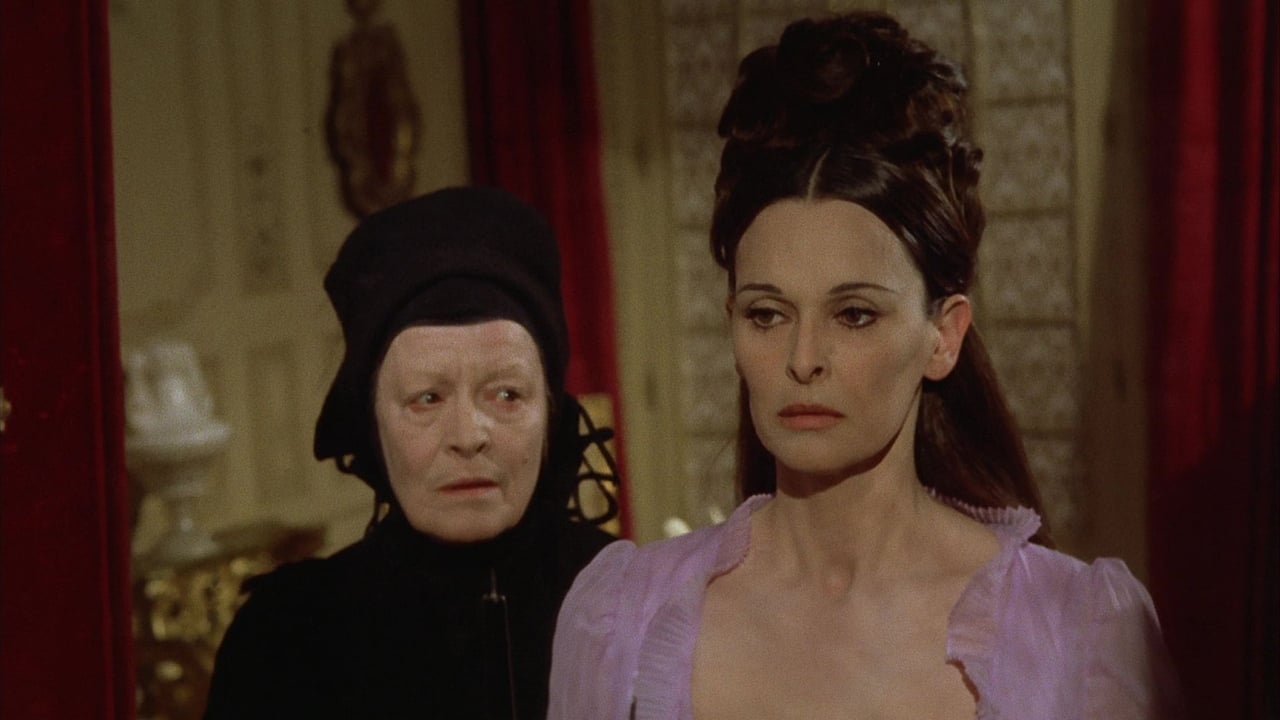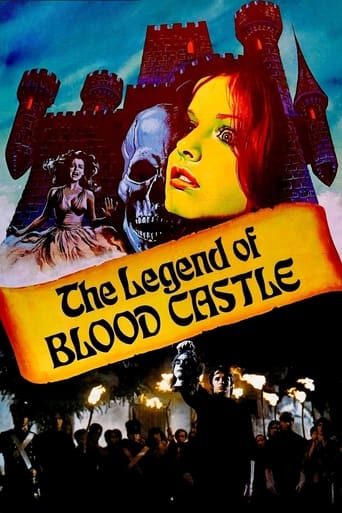



Very Cool!!!
Let's be realistic.
just watch it!
It’s fine. It's literally the definition of a fine movie. You’ve seen it before, you know every beat and outcome before the characters even do. Only question is how much escapism you’re looking for.
View MoreThis is one of those films I said I would watch immediately upon acquiring (in view of its reputation) but only got to check out at a much later stage. Incidentally, I had agonized about whether to purchase the MYA DVD or not because it only featured the clothed Spanish print; eventually, I settled on a fuzzy-looking edition (with at least one noticeable audio drop-out) of the more explicit "International Version" accompanied by unremovable Finnish subtitles! Curiously enough, the copy I watched ran for 86 minutes though other sources claim its full-length as being 102! This is the fourth film I have watched revolving around the legend of Hungarian aristocrat Erzebet Bathory after Hammer's COUNTESS Dracula (1971; in which she was portrayed by the late Ingrid Pitt), Harry Kumel's modern-day rendition DAUGHTERS OF DARKNESS (1971; with Delphine Seyrig) and the third episode of Walerian Borowczyk's IMMORAL TALES (1974; with Paloma Picasso, Pablo's daughter!). I was let down by the Hammer version and, while I admire Borowczyk, the above-mentioned film was not one of his strongest; Kumel's is easily the best of the lot, though it is deemed too arty by some.To get back to Grau, I was very much impressed with BLOOD CEREMONY: it presents a reasonably authentic period and location sense (complemented by Carlo Savina's evocative score) but, more importantly, the plot holds the attention amid the expected violent/nude highlights. Interestingly, Lucia Bose''s Bathory here is not the historical one but rather a descendant of hers who, noticing her looks fading away, is persuaded by her devoted female servant to follow in her ancestor's footsteps; though the original Bathory was said to have killed hundreds of virgin girls and bathed in their blood to sustain her youth, we only get a handful of murders here (though they undeniably exude a kind of gruesome beauty) and, in a couple of cases, one seriously doubts their all-important virtuousness! The film puts forward a number of interesting embellishments to the familiar tale: there is a vampire plague before the protagonist even begins her depredations – though this is eventually revealed as a sham by the skeptical local doctor Silvano Tranquilli; still another 'undead' appears in the form of Bathory's own aristocratic companion – played by Espartaco Santoni (as in Grau's own previous effort, VIOLENT BLOOD BATH [1973], he cuts quite a dashing figure here) – whom she 'wills' into procuring her prey!; an unusual development, and possibly a first in the vampire subgenre, has Bose' being haunted by the decaying corpses of her victims; later still, after she catches Santoni being unfaithful with village beauty Ewa Aulin (this was a fine swan-song for the CANDY [1968] starlet, even if her own role was somewhat underwritten), she kills him and, while his corpse is being tried for his vampiric activities(amusingly presided over by a judge named Helsing!), she calmly confesses all and has no qualms about implicating her elderly accomplice as well!! Their subsequent punishment is quite harsh: the latter has her tongue sliced out, while both are walled up alive inside Bathory's mansion; by the way, the film features some gratuitous animal cruelty to boot (such as falcons chewing on live doves and truant children setting a bat bound to a tree on fire!).Surprisingly, Bose' flourished in this field during the decade – including another collaboration with Aulin, the underrated Giallo THE DOUBLE (1971); she is ideally cast here, though not quite as memorable as Seyrig had been (on a personal note, both actresses had worked for my favorite film-maker, Luis Bunuel, as did character actress Lola Gaos, here playing a sort of witch who advises Aulin on matters of love). The film is extremely well-made for a "Euro-Cult" product (though, again, it does not scale the classy heights of DAUGHTERS OF DARKNESS)...and I am not sure it is not actually superior to Grau's more renowned take on another much-abused monster, the zombie, in THE LIVING DEAD AT THE MANCHESTER MORGUE (1974)! Incidentally, that same year also saw the release of two other excellent Spanish horrors, namely Claudio Guerin Hill's A BELL FROM HELL (completed by Juan Antonio Bardem after the latter's mysterious death) and Bardem's own THE CORRUPTION OF CHRIS MILLER. As for Grau himself, I still have to catch up with his SUMMER NIGHT (1962), an award-winning drama with a good cast (including yet another Bunuel alumnus in Francisco Rabal!)...
View MoreThe picture is set in 1807 , Cajlice , Central Europe . The countess (Lucia Bose) masquerades the death her husband (Espartaco Santoni), as she needs blood to maintain facade of youth . The count abducts gorgeous girls from small village nearby the castle . Meanwhile , he falls in love with a countrywoman (Ewa Aulin) . The girls are killed and finally the countess can take her bath in their blood while being watched by the count .Rather erotic Spanish-Italian co-production plenty of killings , suspense and horror . The story takes parts here and there from Sheridan LeFanu's Carmilla and the legend based on historical figure Elizabeth Bathory . Interesting casting , as an attractive and mature Lucia Bose who long time ago played for Antionini and an elegant noble well played by Espartaco Santoni who acted in various horror films , such as ¨Lisa and devil¨ , ¨Night of the demon¨ , ¨Exorcism's daughter¨. And Ewa Aulin who performed along with Marlon Brando in ¨Cindy¨. Colorful cinematography in Hammer style by Fernando Arribas . Creepy , eerie musical score by Carlo Savina . The motion picture was well directed by Jorge Grau who made a Zombie classic called ¨Living dead at Manchester Morgue¨ or ¨Sleeping corpses lie¨ . Other movies about this Bathory legend are the followings : ¨The countess vampire¨ (72) by Peter Sasdy with Ingrid Pitt and Nigel Green and episode of ¨Immoral tales¨ (1974) by Valerian Borowickz with Paloma Picasso . And referred to Sheridan Le Fanu's Carmilla are ¨The vampire lover¨ (70) by Roy Ward Baker with Ingrid Pitt and Peter Cushing and followed by ¨Lust for vampire¨ (71) by Jimmy Gangster with Ralph Bates and Barbara Jefford.
View MoreJorge Grau's "Blood Ceremony" is probably the best and most faithful adaptation of the story of Elizabeth Barthory, the real life Hungarian countess who bathed in the blood of virgins to keep herself young. (The "Barthory" section in Walerian Borozyx's "Immortal Tales" may be technically better, but Grau is more interested in actually re-telling than the legend here than in seeing how many naked, barely-legal French girls he can squeeze into the frame).Grau does make some interesting alterations to the legend. The countess is helped by her husband who fakes his own death and pretends to be a vampire to fool the superstitious villagers about the source of the exsanguinations. Barthory (Lucia Bose) is also a surprisingly sympathetic character who is only driven to her crimes by mortal despair and the beguilings of her old crone maid. Grau also doesn't make the same mistake as Hammer's "Countess Dracula" where Ingrid Pitt bathes in virgin blood and is instantly transformed from a withered, old hag into. . . well, Ingrid Pitt. It's left much more ambiguous here whether the treatment actually works--it only seems to transform Bose from an attractive older women to a perhaps slightly younger-looking older woman. This is much more effective and chilling than the Hammer histrionics.The highlight of any of these films is, of course, when the character actually takes a literal bloodbath. This scene perhaps isn't as "hot" here as Ingrid Pitt's in "Countess Dracula" or Rosalba Neri's in the non-sensical "Devil's Wedding Night", but it's much more effective cinemagraphically following a stream of blood from an unlucky virgin whose throat has just been slit through a drain in the floor to a shower where Bose is waiting naked below.Besides Bose, the cast also includes Swedish nymphet Ewa Aulin as the gold-digging daughter of the local innkeeper who shares her sexual favors with the count. It's not clear for awhile whether he's going to run off with her or make her another sacrifice to his wife's bloodthirsty vanity. Aulin is a little miscast here and personally I prefer her undubbed (and unclothed), but I guess her natural Swedish accent wouldn't have really worked in Medieval Hungary. The more unknown Spanish actors who play the rest of the villagers are good too. They turn out to be very vindictive and they take a terrible revenge on Barthory at the end (no doubt partially inspired by Edgar Allen Poe's "The Black Cat") that almost makes you feel sorry for her. This is a very good movie and one worthy of a resurrection on DVD.
View MoreThis is a painful, cold, unpleasant but ultimately fascinating entry from the Spanish horror boon that is probably the definitive Elizabeth Bathory treatment, making Hammer's "Countess Dracula" look silly and trite in comparison; that film is a period costume romance compared to BLOOD CASTLE. This is a serious movie that lacks a single light hearted moment, and is a great example of the unbearably suffocating sort of period horror suggested by Michael Reeves' CONQUEROR WORM, which uses the conventions of period horror -- castles, nightgowned beauties, foggy wastes -- to con the viewer into thinking that they are going to get the push-up bras and lesbian nuzzling that these movies usually involve.What you get is actually anti-erotic, much like Reeves' film, unless the idea of watching people suffer is something that gives you a rise. I like this movies' lack of sensationalism, giving us a straightforward almost scientific explanation for the vampirism in question, and providing a sort of tragic Spanish soap opera element to give us the motivations for the murders. The film is indeed slow, but fans of this kind of stuff will be drinking it in, with Jorge Grau's astute eye for period detail, lighting and atmosphere easily putting this on the same plane with films like "Count Dracula's Great Love", "Count Dracula" and the Rollin efforts as amongst the most distinctive films from the Eurohorror boon. No other movie looks quite like LEGEND OF BLOOD CASTLE (or FEMALE BUTCHER, as it is known in it's uncut form), and few have such an unrelenting, claustrophobic air of dread and sheer decrepidness as LEGEND OF BLOOD CASTLE, which completes the CONQUEROR WORM comparison chart by culminating in a series of Inquisitional torture scenes that far surpass the vampire murders in terms of brutality and horror.So perhaps that is Grau's ultimate comment: yes, the Bathory legend speaks of just awful, depraved atrocities, but nothing is quite as atrocious & barbaric as Man's own inhumanity to their fellow Man, and especially with the hypocrisy of the Church feeding the fires of hate. HIGHLY recommended, but not for those with short attention spans or the squeamish alike. And word to the third: The cover shown here is NOT the same movie (that's BLOOD CASTLE, not LEGEND OF BLOOD CASTLE) and beware of a recent North American DVD pressing by a company called MYA: They used a nudity free print with a fullscreen transfer. I've got versions of this film in three languages from twice as many countries: You want the Finnish subtitled English language print called BLOODY CEREMONY. Trust me.7/10
View More